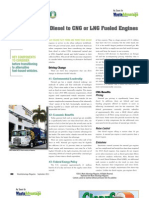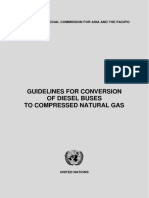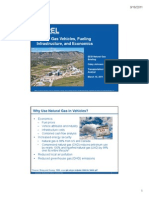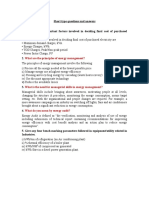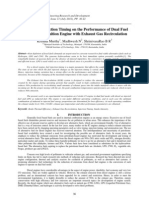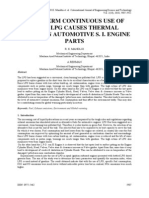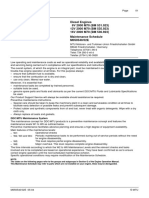Akshay Loyte Review Paper
Akshay Loyte Review Paper
Uploaded by
Amol TembhareCopyright:
Available Formats
Akshay Loyte Review Paper
Akshay Loyte Review Paper
Uploaded by
Amol TembhareOriginal Description:
Copyright
Available Formats
Share this document
Did you find this document useful?
Is this content inappropriate?
Copyright:
Available Formats
Akshay Loyte Review Paper
Akshay Loyte Review Paper
Uploaded by
Amol TembhareCopyright:
Available Formats
Estimation of Power from a Diesel Engine Converted to LPG Gas Operation and Different Alternative S.
I Engine Fuels A Simple Analysis
Akshay Loyte 1, S.M Lawankar 2
1
M.Tech student Goverrment College of Engineering, Amravati, akshayloyte@rediffmail.com 2 Assist. Prof. Goverment College of Engineering, Amravati, l_sm@rediffmail.com
Abstract- The research on alternative fuels has become essential due to depletion of petroleum products and its major contribution for pollutants. In the present work, Liquefied petroleum gas (LPG) has been introduced as an alternative fuel to overcome the above problems. Even though LPG is having high octane number it can be used at higher compression ratio with combustion without knocking. The emission characteristics of HC and CO are better for LPG compared to other fuels like petrol. In this paper, major factors influencing the power output from a gas engine are utilized to predict the power output from a diesel engine converted to gas operation using LPG as gaseous fuels comparing the results with other gaseous and another fuels. The primary factors chosen are the gas calorific value and compression ratio. Analysis is carried out using empirical relationships available from the literature.
I.
INTRODUCTION
Fast depletion of fossil fuels and their detrimental effect on the environment is demanding an urgent need of alternative fuels for meeting sustainable energy demand with minimum environmental impact. A lot of research is being carried out throughout the world to evaluate the performance, exhaust emission and combustion characteristics of the existing engines using several alternative fuels such as hydrogen, compressed natural gas(CNG),alcohols, liquefied petroleum gas (LPG), biogas, producer gas, bio-diesels developed from vegetable oils, and others (Roy et. al, 2010). LPG and CNG are the alternative fuels to be widely adopted for use in the world. Internal combustion engines running on liquid petroleum gas (LPG) are well-proven technologies and work much like gasoline-powered spark-ignition engines. They are typically used as spark-ignition engines for bi-fuelled (gasoline/CH4) cars, but have also been used, for example, in compressionignition (i.e. diesel-type) engines for heavy-duty vehicles. Increasing availability of gaseous fuel and the demand to use them for power generation has led to manufacturing of the gas engines. Most of the engines are modified from diesel engines to run on gas by introducing the ignition, gas governing, and carburetion systems along with change in compression ratio
and in some cases change in the combustion chamber. In a VCR engine thermodynamic benefits appear throughout combustion and small residual gas fraction owing to the engine map. At low power levels, the VCR engine higher compression ratio give faster laminar flame to capture speed. Therefore, the ignition delay period is shorter. While high fuel efficiency benefits are at high power. One major point that is generally considered related to the performance, is the power delivered by the engine compared with the liquid fuel engines of comparable cylinder capacity. The choice of the above mentioned hardware depends on the gaseous fuel to be used. Each of these system components plays an important role in the overall performance of the engine. With many countries like the United States, Italy, Germany, Japan and Canada to name a few switching over to LPG fuel, India does not want to be left far behind. Already, the Indian government has started spreading awareness with respect to the benefits of LPG gas. Many government regulations have also made it mandatory for some public vehicles as well as private ones to use CNG or LPG as the preferred fuel. Not only are these fuels cleaner and greener, they offer the users multiple benefits. The present designs of gas engines adopt most of the hardware related to diesel engines. Thus, a diesel engine is considered as a benchmark for the comparison of the power output of the gas engine. II. PROPERTIES EFFECTING POWER AND EMISSIONS
The output of the engine depends upon the energy content of the air fuel mixture which depends upon the calorific value and stichiometric air requirement, by which the power developed in the cylinder can be determined. The energy density changes with the change in fuel. Internal combustion engines burn fuel to create kinetic energy. The burning of fuel is basically the reaction of fuel with oxygen in the air. The amount of oxygen present in the cylinder is the limiting factor for the amount of fuel that can be burnt. If theres too much fuel present, not all fuel will be burnt and un-burnt fuel will be pushed out through the exhaust valve. When building an engine, its very important to know the air-fuel ratio at which exactly all the available oxygen is
used to burn the fuel completely or at least to the best possible value. This ratio is called the stoichiometric air-fuel ratio. III. LPG EMISSIONS The major harmful emissions from LPG engines are similar to those from other internal combustion engines: Carbon monoxide (CO) Hydrocarbons (HC) Nitrogen oxides (NOX) A. Carbon monoxide CO is generated in the exhaust as the result of incomplete combustion of fuel. CO is a very toxic, colorless and odorless gas. LPG emissions may contain considerable amounts of CO. B. Hydrocarbons Hydrocarbon are also a product of incomplete combustion of fuel. LPG emissions, because of fuel composition, contain only short chain hydrocarbons. They are not likely to contain toxic components which are found in gasoline HC emissions. Also, the environmental impact of LPG hydrocarbon emissions (ozone reactivity contributing to smog) is much smaller than that of gasoline. However, hydrocarbon derivatives are responsible for the characteristic smell which is often a nuisance when LPG engines operate indoors. C. Nitrogen oxides Nitrogen oxides are generated from nitrogen and oxygen under the high temperature and pressure conditions in the engine cylinder. NOX consists mostly of nitric oxide (NO) and some nitrogen dioxide (NO2). Emissions from LPG engines also depend heavily on the engines state of tune. An example plot illustrating the CO levels for different air to fuel ratios is shown in Figure1. Carbon monoxide emissions skyrocket when the mixture becomes rich. The importance of proper engine tune-up and maintenance for low emissions cannot be overestimated.
modifying engine design and making use of proper mixtures and catalysts to keep a check on the pressure and temperature of the fuel. The fuel combustion process takes place under very hot and pressurized conditions and to avoid any unsafe consequences, excess air operations are carried out. Excess air level keeps a check on the various factors like fuel composition variation, oxygen availability and pressure, that can lead to an explosion. Air fuel meters or air fuel gauges are used to measure the air to fuel ratio of engines. Wideband oxygen sensors are used to measure the air-fuel ratio of ICEs. The stoichiometric air fuel ratio for different fuels are as indicated below Natural gas: 17.2 Gasoline: 14.7 Propane: 15.5 Ethanol: 9 Methanol: 6.4 Hydrogen: 34 Diesel: 14.6 Biogas: 10.5 LPG: 15.8
It is found that the air-fuel ratio requirement of LPG is having value which suits best for using LPG as a alternative fuel. IV. SOURCE OF LPG The major sources of LPG are natural gas processing and petroleum refining. Raw natural gas often contains excess propane and butane which must be removed to prevent their condensation in high-pressure pipelines. In petroleum refining, LPG is collected during distillation, from lighter compounds dissolved in the crude oil, as well as generated in the "cracking" of heavy hydrocarbons. Therefore, LPG can be considered a by-product and its exact composition and properties will vary greatly with the source. LPG provides about 8% more energy per unit weight (LHV = 19,757 BTU/lbm) than gasoline. Theoretically, vehicle operation with LPG should be more efficient than with gasoline, i.e., the vehicle should attain better specific fuel consumption and improved mileage. However, this will only happen if the engine design is optimized for LPG fuel. If a gasoline engine is converted to operate on LPG this increased efficiency will not be realized due to the lower density of LPG compared to gasoline and also its slightly higher oxygen demand (LPG stoichiometric A/F = 15.8). The lighter density fuel displaces air in the intake manifold, and thus, less air per cycle is induced to the cylinders. This translates to a decreased volumetric efficiency and a loss of power compared to the original gasoline rating of the engine.
Fig 1. Sensitivity of LPG Emissions to A/F Ratio
As every combustion cycle in an ICE is short lived, so it becomes almost impossible to achieve the ideal ratio. However, air-fuel ratios close to it can be achieved by
V. PROPERTIES OF GASEOUS
FUELS
TABLE 2 Calorific Value of Some Fuels Fuel Higher Calorific Value (Gross Calorific Value)
Gaseous fuels in common use are liquefied petroleum gases (LPG), Natural gas, producer gas, blast furnace gas, coke oven gas etc. The calorific value of gaseous fuel is expressed in Kilocalories per normal cubic meter (kCal/Nm3) i.e. at normal temperature (20oC) and pressure (760 mm Hg) Since most gas combustion appliances cannot utlilize the heat content of the water vapour, gross calorific value is of little interest. Fuel should be compared based on the net calorific value. Typical physical and chemical properties of various gaseous fuels can be given as under
TABLE 1 Typical Physical and Chemical Properties of Various Gaseous Fuels Fuel Gas Relative Density Higher Heating Value 3 Kcal/Nm 9350 22200 28500 Air/Fuel ratio m3 of air to 3 m of fuel 10 25 32 Flame Temp. oC Flame Speed m/s
Diesel
44,800 KJ/Kg
19,300 Btu/lb
Gasoline
47,300 KJ/Kg
20,400 Btu/lb
Propane C3H8
101,000kJ/m3
2550 Btu/ft3
Butane C4H10
133,000kJ/m3
3200 Btu/ft3
Methane CH4
39,820 kJ/m3
Natural Gas Propane Butane
0.6 1.52 1.96
1954 1967 1973
0.290 0.460 0.870
1 kJ/kg = 1 J/g = 0.4299 Btu/ lbm = 0.23884 kcal/kg1 Btu/lbm = 2.326 kJ/kg = 0.55 kcal/kg 1 kcal/kg = 4.1868 kJ/kg = 1.8 Btu/lbm 1 dm3 (Liter) = 10-3 m3 = 0.03532 ft3
LPG is a predominant mixture of propane and Butane with a small percentage of unsaturates (Propylene and Butylene) and some lighter C2 as well as heavier C5 fractions. Included in the LPG range are propane (C3H8), Propylene(C3H6), iso-butane (C4H10) and Butylene(C4H8). The boiling point of LPG normally ranges anywhere between -42 degrees to 0 degree. The boiling point depends on what proportions are Butane and Propane present in the mixture. LPGs Flash point is -76 degrees Fahrenheit. The ignition temperature of LPG is found to be in the range of 410 to 580 deg Celsius. LPG has a typical specific calorific value of 46.1 MJ/kg compared with 42.5 MJ/kg for fuel-oil and 43.5 MJ/kg for premium grade petrol (gasoline). However, its energy density per volume unit of 26 MJ/l is lower than either that of petrol or fuel-oil. LPG evaporates quickly at normal temperatures and pressures and is supplied in pressurised steel cylinders. They are typically filled to between 80% and 85% of their capacity to allow for thermal expansion of the contained liquid.
VI. EFFECT OF COMPRESSION RATIO ON POWER OUTPUT
AND EFFICIENCY
The power delivered from an engine is directly proportional to the mean effective pressure (mep) developed in the engine cylinder. The fuel conversion efficiency, i.e. sum of thermal and mechanical efficiency, increases with increase in compression ratio, implying the power output increases with compression ratio under a given set of operating conditions. Relative engine performance measure is obtained by dividing the work per cycle by the cylinder volume displaced per cycle. The parameter so obtained has units of force per unit area and is called the mean effective pressure (mep). Work per cycle = mep = P R ---------------- (1) N P R -----------------------(2) Vd N
Otto Cycle Efficiency = 1- 1 rc-1 -------------- (3)
where, P, R are the Power and the number of crank revolutions for each power stroke per cylinder. N is the engine speed (rpm), rc is the compression ratio. From the above expressions (1) (3), power output is related to the compression ratio through the mean effective pressure and the cycle efficiency. Heywood [1] indicates that only few studies have focused on the effect of compression ratio on engine performance and efficiency over a wide range of compression ratios in the case of a spark ignited engines. The basic limitation in using higher compression ratio for spark-ignited engines arises out of the properties of the fuel used. The range of operating compression ratio found the literature is between 8 and 14. For spark- ignited engines with the compression ratio less than 12, for a unit change of compression ratio, the output changes by about 3 % [1]. Engine efficiency also gets affected due to the change in compression to similar extent [1]. Depending upon the cylinder sizes and the operating conditions, Heywood indicates that, for a unit change in the compression ratio in the range of 9 to 11, the relative change in efficiency is between 1 and 3 percent. Further in a detailed work carried out the by Kerley and Thruston [5], the effective change in efficiency is found to be in the range of 1 1.4 % per unit change in compression ratio. It is also found from the work of Sridhar et al [6], that the factor is about 1.3 per unit change in compression ratio with different operating conditions.
efficiency is about 3 % per unit change in compression ratio in the range of rc < 12 and is about 1.8 to 2.4 in the range of compression ratio between 12 and 17. Based on the results available from other sources presented here and the non availability of any commercial data in this regard, it is assumed a change of a 1.5 % in efficiency for unit change of compression ratio for the gas engines under consideration. As the compression ratio variation effects the engine efficiency, so depending upon the cylinder sizes and the operating conditions, the effect of compression ratio on efficiency a single cylinder (Mak-25) variable compression ratio spark ignition engine was used. The specifications of test engine are shown in Table 3, The test fuels used are gasoline, liquefied petroleum gas, gasoline and ethanol blends (10%, 15%, 25%, and 35%, of ethanol with gasoline by volume). Also, the gasoline is blended with kerosene at different proportions by volume (K15, K25, and K35). The experiment was performed at four different compression ratios (4.6:1, 6:1, 8:1, 9:1) for each fuel and the effect of engine performance was investigated.
TABLE 3. Principal specifications of test engine SPECIFICATION BHP (Mak-25) Rated speed Number of cylinders Compression Ratio Bore Stroke length Type of ignition Method of loading Method of starting Method of cooling 2.5 3000 RPM 1 2.5:1 TO 10:1 70 mm 66.7 mm Spark ignition Eddy current dynamometer Crank start Air cooled VALUE
Fig.2. Variation of efficiency with compression ratio
Fig.2 shows the variation of normalized efficiency with compression ratio using the ideal efficiency relation (eq. 3) for = 1.4. Efficiency obtained with compression ratio of 8 is used to normalize the efficiency calculated using other compression ratios. From the experimental analysis Heywood presents the details of an 8-cylinder engine with wide open throttle having similar features as in Figure 2. The change in
For all compression ratios, the volumetric efficiency is increasing with load. The highest volumetric efficiency is seen with LPG as a fuel. This is attributed to be the proper mixing of the fuel and air. As the calorific value of the LPG is more, the amount of fuel required per cycle may be is less and hence the requirement of oxygen may be less. The variation of volumetric efficiency at all compression ratios for all the fuels used is with in 6%. This indicates that the volumetric efficiency variation with different fuels more or less constant. The exhaust emissions of CO and CO2 gas of the engine at different compression ratios at a particular load and at constant rotational speed is measured and presented in the
form of bar charts as shown in Figures. It is clearly seen that the Carbon monoxide emission is highest, when the engine is working with petrol blended with 35% kerosene (by volume), and lowest when working with LPG. This may be due to incomplete combustion of kerosene and complete combustion, when the LPG is used as a fuel. The values for other fuels are in between LPG and petrol and K35. The carbon monoxide emission is reducing with increasing compression ratio. Similarly, the Carbon dioxide emission is shown in Figure 4. The variation of carbon dioxide emission is also highest for petrol with K35 and lowest for pure petrol. The carbon dioxide emission is reducing with increase in compression ratio. This is attributed that at higher compression ratio, combustion process is better due to high temperature at constant speed.
the power from a diesel engine converted to run on gas is brought out. The parameters chosen for the analysis are related to the properties of the fuel and the only other parameter from the engine is the compression ratio. The influence of the fuel properties on the peak temperature and pressure has been used for the analysis. From the results it is clear that the simple analysis using empirical relations seems to predict the power output of a diesel engine modified to operate on gas quite satisfactorily. It is observed that the LPG is a promising fuel at all loads lesser carbon monoxide emission compared with other fuels tested. Internal combustion engines running on liquid petroleum gas (LPG) are well-proven technologies and work much like gasoline-powered spark-ignition engines. One major point that is generally considered related to the performance, is the power delivered by the engine compared with the liquid fuel engines of comparable cylinder capacity. The choice of the above mentioned hardware depends on the gaseous fuel to be used and it is observed that Liquefied petroleum gas has proven the efficient alternative fuel. REFERENCES
[1] [2] Heywood John B. Internal combustion engine fundamentals, International edition, New York : McGraw -Hill, 1989. Amjad Shaik*, N Shenbaga Vinayaga Moorthi, and R udramoorthy Variable compression ratio engine: a future power plant for automobiles an overview Department of Automobile Engineering, PSG College of Technology, Peelamedu, Coimbatore, India 19 February 2007 Cummins gas engines brochure; bulletin no 3243558:01 dated 31.5.91 S Dasappa, on the estimation of power from a diesel engine converted for gas operation a simple analysis ASTRA ,Indian Institute of Science,Bangalore ,India Kerley R V and Thurston K W, The indicated performance of Otto-cycle engines, SAE Trans, Vol. 70, pp 5 37, 1962. Sridhar G, Paul P J and Mukunda H S, Biomass derived producer gas as a reciprocating engine fuel an experimental analysis, Journal of Biomass and Bioenergy, vol. 21 p 61 -72 Vezir Ayhan*, Adnan Parlak, Idris Cesur, Bari_ Boru and Ahmet Kolip, Performance and exhaust emission characteristics of a diesel engine running with LPG Technical Education Faculty, Sakarya University, Serdivan/ Sakarya, Turkey 31 March, 2011 Homeyer C, Choi GH, Kim JH, Effects of different LPG fuel systems on performances of variable compression ratio single cylinder engine ASME Intern Combust Eng. Div., 39: 369375,2002 Miller J, Nagarajan J, Renga Narayanan S, Experimental studies on homogeneous charge CI engine fueled with LPG using DEE as an ignition enhancer, Renewable Energy, 32: 15811593,2007
[3]
Fig.3- Variation of carbon monoxide emission at constant
speed and 4.5 kgf load when the engine is tested at different compression ratios with different pure and blended fuels.
[4]
[5] [6]
[7]
[8]
Fig.4- Variation of carbon dioxide emission at constant speed
and 4.5 kgf load when the engine is tested at different compression ratios with different pure and blended fuels.
[9]
VII. CONCLUSION Increasing availability of gaseous fuel and the demand to use them for power generation has led to manufacturing of the gas engines. Most of the engines are modified from diesel engines to run on gas by introducing the ignition, gas governing, and carburetion systems along with change in compression ratio and in some cases change in the combustion chamber. The higher cylinder pressures changing the combustion chamber volume. A simple procedure to estimate
[10] N. Seshaiah, Efficiency and exhaust gas analysis of variable compression ratio spark ignition engine fuelled with alternative fuels M.I.T.S, Madanapalle, Angallu-517325, A.P, India 2010 [11] Greaves operation manual, 1991. [12] Rothlisberger R and Leyland G, report on Swiss motor, modification dun moteur diesel pour le report on Swiss motor,
modification dun moteur diesel pour le fonctionmenent an gaz naturel en cogeneration, fonctionmenent avec mlange stoechiometrique (l = 1) et pauvre (l>>1), Office federal de Ienergie, from EPFL, 3003 Berne, Switzerland, April 1998. [13] Subbukrishna D N, Dasappa S, Paul P J, Rajan NKS and Mukunda HS, Technical Report, Indian Institute of Science , Performance of gas engines using sweetened biogas obtained from distillery effluent treatment plants at M/s Ugar sugars and M/s KCP sugars, March 2001. [14] Nett Technologies Inc. LPG emissions manual, 2-6707 Goreway Drive, Mississauga, Ontario, Canada [15] Yecesu, H.S; Topgul, T; Cinar, C; Okur, M; Effect of ethanolgasoline blends on engine performance in different compression ratios, Applied Thermal Engineering Vol.26; 2006. [16] Das, L. M.; Rohit Gulati; Gupta, P. K.; A comparative evaluation of the performance characteristics of a spark ignition engine using hydrogen and compressed natural gas as alternative, International Journal of Hydrogen Energy, Vol. 25, Issue 8, August 2000
You might also like
- Chrysler EcoDiesel 3.0L R00Document5 pagesChrysler EcoDiesel 3.0L R00Phoo NgoneNo ratings yet
- Drivers Manual SB 4000pf - XF Euro 3 - Training Registration SystemDocument106 pagesDrivers Manual SB 4000pf - XF Euro 3 - Training Registration SystemПавел ПогребнойNo ratings yet
- Combustion Plate 1Document26 pagesCombustion Plate 1Marc Bitang100% (3)
- DAF Model Overview Axle ConfigurationsDocument2 pagesDAF Model Overview Axle ConfigurationsapNo ratings yet
- Solar Installation ManualDocument12 pagesSolar Installation ManualdineshNo ratings yet
- W1508Document29 pagesW1508Kedhar MallaNo ratings yet
- Auto & WorkshopDocument36 pagesAuto & Workshopmike100% (1)
- Membrane and Separation Technology NewsDocument16 pagesMembrane and Separation Technology NewsGerald100% (2)
- Yanmar 6ly3 Parts Catalog PDFDocument58 pagesYanmar 6ly3 Parts Catalog PDFMaxim100% (1)
- Despiece Desmalezadora Husqvarna 143RII PDFDocument35 pagesDespiece Desmalezadora Husqvarna 143RII PDFbryanaranzazuNo ratings yet
- Pneumatic Circuit Design AnalysisDocument7 pagesPneumatic Circuit Design AnalysismebrahtuNo ratings yet
- Switching From DieselDocument2 pagesSwitching From DieseljohnribarNo ratings yet
- Chapter 5 PDFDocument26 pagesChapter 5 PDFHari650No ratings yet
- YANMAR Technical Review Dual FuelDocument12 pagesYANMAR Technical Review Dual FuelKarim Sowley DelgadoNo ratings yet
- Asian33 112009Document40 pagesAsian33 112009irmuhidinNo ratings yet
- Buses Diesel A CNGDocument39 pagesBuses Diesel A CNGCarlos Loler NavarroNo ratings yet
- DAF Components BrochureDocument9 pagesDAF Components Brochurerichard musondaNo ratings yet
- Daf OptimizationDocument162 pagesDaf OptimizationIrene Ortiz TallónNo ratings yet
- Natural Gas StudyDocument17 pagesNatural Gas StudyAnton HendraNo ratings yet
- DAF LF Euro 6 Brochure 64354 HQ GBDocument32 pagesDAF LF Euro 6 Brochure 64354 HQ GBedubarbier100% (1)
- 590 Direct Satellite Television BroadcastingDocument13 pages590 Direct Satellite Television BroadcastingKedhar MallaNo ratings yet
- CNG Engine PDFDocument11 pagesCNG Engine PDFFaisal RahmanNo ratings yet
- 29 Avanza (Cont. Next Page) : Engine Control (From Aug. 2015 Production)Document5 pages29 Avanza (Cont. Next Page) : Engine Control (From Aug. 2015 Production)Eko Bambang KiswantoNo ratings yet
- Solar Power InstallationDocument5 pagesSolar Power InstallationVer BautistaNo ratings yet
- Design of Exhaust Gas Heat ExchangerDocument56 pagesDesign of Exhaust Gas Heat ExchangerAnkit saxena100% (11)
- CNG 101: Basic Questions About Natural Gas As A Transportation FuelDocument2 pagesCNG 101: Basic Questions About Natural Gas As A Transportation FuelPawan ChaturvediNo ratings yet
- Compressed Natural Gas PDFDocument14 pagesCompressed Natural Gas PDFAli AyanNo ratings yet
- Natural Gas Vehicles, Fueling Infrastructure, & EconomicsDocument8 pagesNatural Gas Vehicles, Fueling Infrastructure, & EconomicsSukrit N.No ratings yet
- Compressed Natural Gas PDFDocument14 pagesCompressed Natural Gas PDFrizky wahyuNo ratings yet
- CNG Compressors: Fueling Natural Gas VehiclesDocument9 pagesCNG Compressors: Fueling Natural Gas VehiclesKASIMNo ratings yet
- 2010 NEXIQ Catalog PDFDocument12 pages2010 NEXIQ Catalog PDFMiguel ChaconNo ratings yet
- Compressed Natural GasDocument16 pagesCompressed Natural GasEr Dinesh TambeNo ratings yet
- Different Methods To Control Fan SpeedDocument3 pagesDifferent Methods To Control Fan SpeedKenneth MikeNo ratings yet
- CNG Base Training2Document74 pagesCNG Base Training2Interogator5100% (2)
- Adblue Euro5Document32 pagesAdblue Euro5Juan Manuel Llorente VaraNo ratings yet
- Gasifier Engine SystemDocument7 pagesGasifier Engine SystemRajkumar MeenaNo ratings yet
- 2012 Lexus ct200h 50Document82 pages2012 Lexus ct200h 50freezifateNo ratings yet
- CNG Industry: Compiled byDocument7 pagesCNG Industry: Compiled byAbdullah HussainNo ratings yet
- AP0806720 XC88x Cookery BookDocument119 pagesAP0806720 XC88x Cookery BookЮрий ВетровNo ratings yet
- Euro 4 - Euro 5 SCR Versus EGR: BackgroundDocument4 pagesEuro 4 - Euro 5 SCR Versus EGR: Backgrounddriverar80No ratings yet
- Us Truck ShopsDocument3 pagesUs Truck ShopsstankhaNo ratings yet
- Tech Doc Def Iso22241 Jul2022Document1 pageTech Doc Def Iso22241 Jul2022Wael MohammedNo ratings yet
- Financial ProjectionDocument25 pagesFinancial ProjectionHimangi GuptaNo ratings yet
- VSD The Impact of Hybrid and Electric Powertrains On Vehicle Dynamics Control Systems and Energy RegenerationDocument18 pagesVSD The Impact of Hybrid and Electric Powertrains On Vehicle Dynamics Control Systems and Energy RegenerationMahmoud AbuziadNo ratings yet
- Basic Hydraulics and PneumaticsDocument36 pagesBasic Hydraulics and PneumaticsKush Dilwal100% (1)
- Car EngineDocument9 pagesCar Engineayesha amjadNo ratings yet
- Ch.2 QADocument9 pagesCh.2 QArogers4759100% (1)
- Knight Service ManualDocument48 pagesKnight Service ManualKevin JonesNo ratings yet
- VECU - Manual de Producción 70312913Document33 pagesVECU - Manual de Producción 70312913RainorSS100% (2)
- Autel MaxiScope MP408 - AUTOMOTIVE OSCILLOSCOPEDocument2 pagesAutel MaxiScope MP408 - AUTOMOTIVE OSCILLOSCOPEMAK OBDNo ratings yet
- Euro VI Technologies and Costs For Heavy Duty Vehicles The Expert Panels Summary of Stakeholders Responses Contract no.:070501/2004/381669/MAR/C1Document56 pagesEuro VI Technologies and Costs For Heavy Duty Vehicles The Expert Panels Summary of Stakeholders Responses Contract no.:070501/2004/381669/MAR/C1Akshay GuptaNo ratings yet
- Exhaust Emission Reduction Technologies For Diesel Engines: Pankaj Gupta 142116517 Stress and VibrationDocument25 pagesExhaust Emission Reduction Technologies For Diesel Engines: Pankaj Gupta 142116517 Stress and VibrationTushar RadkarNo ratings yet
- Fundamentals of AutomotiveDocument29 pagesFundamentals of AutomotiveVon CanlasNo ratings yet
- Accent P0036 HO2S Heater Control Circuit IncorrectDocument7 pagesAccent P0036 HO2S Heater Control Circuit Incorrectflash_24014910No ratings yet
- Electric Vehicle MarketDocument17 pagesElectric Vehicle Marketramaswamykama786No ratings yet
- DD55468 Rev01 Analog Tacho Recert TrainingDocument80 pagesDD55468 Rev01 Analog Tacho Recert TrainingGerson FloresNo ratings yet
- Diesel Exhaust SootDocument9 pagesDiesel Exhaust Sootharshal161987No ratings yet
- Flex Ray Communication SystemDocument245 pagesFlex Ray Communication SystemsusannulNo ratings yet
- Chapter-1: 1.1 Compression Ignition Engine EmissionsDocument14 pagesChapter-1: 1.1 Compression Ignition Engine EmissionsRavi AnuNo ratings yet
- Influence of Injection Timing On The Performance of Dual Fuel Compression Ignition Engine With Exhaust Gas RecirculationDocument7 pagesInfluence of Injection Timing On The Performance of Dual Fuel Compression Ignition Engine With Exhaust Gas RecirculationIJERDNo ratings yet
- 4.0. LPG As An Alternate Fuel For Ic EnginesDocument14 pages4.0. LPG As An Alternate Fuel For Ic EnginesSivashankar DhanarajNo ratings yet
- Experimental Investigation On SI Engine Fueled With CNG-Biogas BlendsDocument4 pagesExperimental Investigation On SI Engine Fueled With CNG-Biogas Blendsnalanth76No ratings yet
- Long Term Continuous Use of Auto-Lpg Causes Thermal Pitting in Automotive S. I. Engine PartsDocument5 pagesLong Term Continuous Use of Auto-Lpg Causes Thermal Pitting in Automotive S. I. Engine Partsmanit1963No ratings yet
- Volvo D13H Shop Armed Vol1Document33 pagesVolvo D13H Shop Armed Vol1Roberth Sanchez100% (1)
- Fuel PumpDocument4 pagesFuel PumpWeird WNo ratings yet
- MB Approved OilsDocument10 pagesMB Approved OilssirlancelotksaNo ratings yet
- Red Max G2500TS PDFDocument36 pagesRed Max G2500TS PDFKevinNo ratings yet
- PC200-7 Piston Pump PartsDocument15 pagesPC200-7 Piston Pump Partseshopmanual limaNo ratings yet
- Husaberg 2000Document34 pagesHusaberg 2000ktm7ak100% (1)
- Breaker AH 201: Item Quan-Tity Name Material NoDocument2 pagesBreaker AH 201: Item Quan-Tity Name Material NoPappa Anton FlorinNo ratings yet
- Diesel Engines 8V 2000 M70 (BM 531.923) 12V 2000 M70 (BM 535.923) 16V 2000 M70 (BM 536.923) Maintenance Schedule M050540/02EDocument4 pagesDiesel Engines 8V 2000 M70 (BM 531.923) 12V 2000 M70 (BM 535.923) 16V 2000 M70 (BM 536.923) Maintenance Schedule M050540/02EsxturboNo ratings yet
- 4 Kia Spotage 2010Document13 pages4 Kia Spotage 2010Jorge VillamilNo ratings yet
- The Nacelle How Does It WorkDocument2 pagesThe Nacelle How Does It WorkJayDeep KhajureNo ratings yet
- Yuminashi Pgma-Fi ManualDocument16 pagesYuminashi Pgma-Fi ManualTechno TechNo ratings yet
- Emsco FB13/1600 Module Exploded ViewDocument3 pagesEmsco FB13/1600 Module Exploded ViewJESUS ANTONIO100% (1)
- Ej800agfph (2016) W800 PDFDocument83 pagesEj800agfph (2016) W800 PDFAlbert DepanoNo ratings yet
- Vp125 Fi (Sj25jb)Document115 pagesVp125 Fi (Sj25jb)Greg LeeNo ratings yet
- ECE309 S15 ProjectDocument5 pagesECE309 S15 Projectvoid20No ratings yet
- DC1686A 566kWDocument2 pagesDC1686A 566kWChristopherNo ratings yet
- How To Check and Adjust Diesel Engine Valve Clearance by Starlight Generator MediumDocument1 pageHow To Check and Adjust Diesel Engine Valve Clearance by Starlight Generator Mediumspkdtjzrg9No ratings yet
- Service - Manual - CLASSIC 500 - 350 PDFDocument229 pagesService - Manual - CLASSIC 500 - 350 PDFsandystays100% (2)
- Caterpillar Cat 235 EXCAVATOR (Prefix 62X) Service Repair Manual (62X00001-00288)Document23 pagesCaterpillar Cat 235 EXCAVATOR (Prefix 62X) Service Repair Manual (62X00001-00288)rpoy9396615No ratings yet
- Hatlapa Compressor L Series L220 L2Document2 pagesHatlapa Compressor L Series L220 L2Jan0% (1)
- DTC List MT05 Rev4 3Document1 pageDTC List MT05 Rev4 322102826No ratings yet
- Engine Emission and ControlDocument21 pagesEngine Emission and Controlshamiul himelNo ratings yet
- Exam QuestionsDocument7 pagesExam QuestionsGabrielNo ratings yet
- Makita DCS6401 PDFDocument11 pagesMakita DCS6401 PDFIvorNo ratings yet
- Cylinder Block 26227236Document3 pagesCylinder Block 26227236dharmawan100% (1)
- PM Tuning Scooter Tuning GuideDocument2 pagesPM Tuning Scooter Tuning GuidesunwindionNo ratings yet











